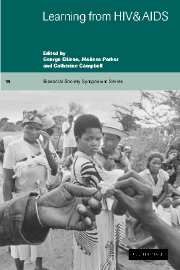Book contents
- Frontmatter
- Contents
- List of contributors
- Foreword by D. Clarke-Patel
- 1 Introduction. Learning from HIV and AIDS: from multidisciplinary to interdisciplinarity
- 2 HIV and the evolution of infectious diseases
- 3 The epidemiology of HIV/AIDS: contributions to infectious disease epidemiology
- 4 The influence of HIV/AIDS on demography and demographic research
- 5 What have clinicians learnt from working with HIV/AIDS? A medical perspective from London
- 6 How has the HIV/AIDS pandemic contributed to our understanding of behaviour change and health promotion?
- 7 Anthropological reflections on HIV prevention strategies: the case for targeting London's backrooms
- 8 An absence of anthropology: critical reflections on anthropology and AIDS policy and practice in Africa
- 9 A disaster with no name: the HIV/AIDS pandemic and the limits of governance
- 10 Postscript: reflections on HIV/AIDS and history
- Country index
- Subject index
- References
1 - Introduction. Learning from HIV and AIDS: from multidisciplinary to interdisciplinarity
Published online by Cambridge University Press: 14 January 2010
- Frontmatter
- Contents
- List of contributors
- Foreword by D. Clarke-Patel
- 1 Introduction. Learning from HIV and AIDS: from multidisciplinary to interdisciplinarity
- 2 HIV and the evolution of infectious diseases
- 3 The epidemiology of HIV/AIDS: contributions to infectious disease epidemiology
- 4 The influence of HIV/AIDS on demography and demographic research
- 5 What have clinicians learnt from working with HIV/AIDS? A medical perspective from London
- 6 How has the HIV/AIDS pandemic contributed to our understanding of behaviour change and health promotion?
- 7 Anthropological reflections on HIV prevention strategies: the case for targeting London's backrooms
- 8 An absence of anthropology: critical reflections on anthropology and AIDS policy and practice in Africa
- 9 A disaster with no name: the HIV/AIDS pandemic and the limits of governance
- 10 Postscript: reflections on HIV/AIDS and history
- Country index
- Subject index
- References
Summary
This disease is not like any other … in the 20 years since the disease was recognised, more than 20 million people have died from it. Another 40 million are infected. New infections are occurring at the rate of 15,000 a day, and the rate is still increasing. Unless there is a significant change for the better almost all these people will die.
The Economist, July 11th 2002[A]t current infection rates, AIDS, the deadliest epidemic in human history, will kill 68 million people in the 45 most affected countries over the next 20 years …”
Peter Piot, Executive Director of UNAIDS, writing in the New York Times in July 2002‘Learning from HIV and AIDS’ – a multidisciplinary symposium of the UK BioSocial Society
Mindful of the extraordinary contribution made by health professionals, academics, policy makers and the communities worst affected to understand and respond to HIV/AIDS, the UK BioSocial Society invited representatives from these groups to a multidisciplinary symposium held at the Institute of Education in May 2001. The sheer scale of the HIV/AIDS pandemic has resulted in unprecedented research activity, both theoretical and applied, and has led to a huge array of formal and informal publications (ranging from dedicated academic journals and professional texts, to local newsletters and global websites). For the most part, however, these cover responses to HIV/AIDS – at the individual-, familial-, communal-, institutional-, national-, regional- and global-level.
- Type
- Chapter
- Information
- Learning from HIV and AIDS , pp. 1 - 31Publisher: Cambridge University PressPrint publication year: 2003
References
- 1
- Cited by



